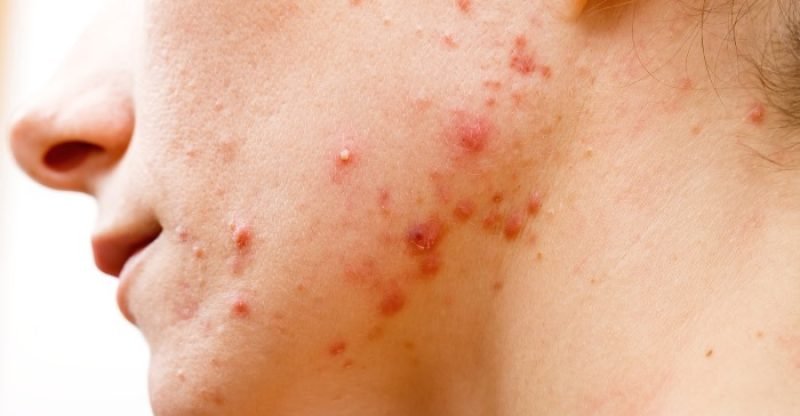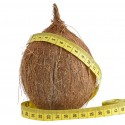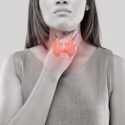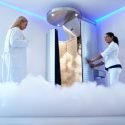Cystic Acne Symptoms, Causes and 20 Natural Treatments
People of all ages and both sexes can suffer from a variety of types of acne.
Cystic acne can cause pain and scarring.
This article can help an individual understand the causes and symptoms of this type of acne.
I will also provide twenty remedies to help cure cystic acne.
Make sure to read the entire article, in order to gain useful information that can change your life if you suffer from cystic acne life.
What is Cystic Acne?
Cystic acne is the cruelest form of acne. It includes red, massive, painful breakouts.
It is mainly found on the face, but also on the chest, upper arms, shoulders, and back.
This type of acne is also called nodulocystic acne.
It can cause cysts and nodules to appear on the skin.
These cysts and nodules are caused by an infection deep under the skin.
This infection creates painful bumps that are full of bacteria and pus.
A variety of items can cause cystic acne, but it is most commonly found in boys during puberty.
However, people as young as eight and as old as fifty can be affected by cystic acne.
Nevertheless, the most common age groups are teenagers and people in their early twenties.
Hormonal imbalances make cystic acne worse for adult males.
During menstrual cycles and other hormonal changes in women, this type of acne is typically found on the chin and jawline.
When a cyst bursts, it can cause an increase in breakouts.
This increase is caused by the infection spreading into other pores.
Signs and Symptoms of Cystic Acne
A variety of signs and symptoms are associated with cystic acne.
Here are some of them:
- Raised lumps, which are up to one inch thick.
- The affected area is painful when touched.
- The area is itchy and irritated.
- A throbbing sensation is felt in the area of a cyst.
- The infected area is tender.
- The raised lumps and nodules do not have white heads.
- Breakouts come with multiple cysts and nodules.
- Cysts and nodules come with inflammation and redness.
- Cystic acne can appear in a variety of areas of the body, including the scalp, chest, back, and shoulders.
Cystic Acne Causes
When learning how to get rid of cystic acne, you must first examine its causes.
One of the most common reasons is genetics.
Typically, cystic acne runs from generation to generation.
If one of your parents has extreme cystic acne, you also have a much higher chance of having it.
Hormones are a common cause of cystic acne.
Androgens increase in boys during the teen years, and they can increase your chance of developing cystic acne.
If you live in an area with high humidity or you sweat a lot, you’ll have more of a chance of having cystic acne.
Specific products for the body and face can be irritating and clog pores, which can also cause cystic acne.
This fact is also true for a variety of drugs and chemicals, which can cause or worsen the eruptions of acne.
The above items are just a few of the most common causes of cystic acne.
The following items can also contribute to it:
- Holding your face against the pillow when sleeping.
- Infrequently washing your face.
- Consistently touching your face.
- Experiencing high levels of stress.
Cystic Acne Natural Treatments
Vitamin C
Vitamin C is one of the best remedies for acne — because it supports your immune system, and will help increase the production of white blood cells.
These blood cells are one of the primary ways that the body fights any type of infection, including cystic acne.
When your body increases the production of white blood cells, it sends them directly to the infected area, which reduces the recovery time.
You will need 100% Vitamin C tablets, which can be purchased at any pharmacy.
You can take one pill twice each day.
But to guarantee better absorption, it is important to drink eight ounces of water with each pill.
Tea Tree Oil
Tea tree oil naturally occurs in nature and is one of the most potent antibacterial agents.
Once it is applied to the infected area, tea tree oil acts fast.
It dries the area, reduces itchiness, and provides disinfection deep in the pores.
The only two items needed for this remedy are 100% tea tree oil and swabs.
The first step is to cleanse and dry the area to be treated.
Then dip the swab into the tea tree oil, and apply it directly to the cystic acne.
Do not wash the area. To get the best results, let it dry overnight.
In the morning, you should clean the area with warm water.
This process should be repeated nightly.
It is essential to make sure that you only use tea tree oil externally because it is poisonous if swallowed.
To identify any reactions, it may be necessary to test an uninfected area of the skin.
Coconut Oil
Coconut oil helps support the rehydration of your skin.
While it rehydrates the skin, it also fights bacteria, which makes it an excellent way to treat cystic acne.
Due to the antibacterial agents in this oil, coconut oil will promote gentle, fast healing.
The only required ingredients for this remedy are unrefined organic coconut oil and swabs.
You should wash the infected area with soap and warm water.
Then the area should be patted dry with a towel.
Once the area is clean, you should dip the swab into five to ten drops of coconut oil.
These drops of oil should be applied directly to the affected area.
They should be left on the skin overnight, and rinsed with warm water the next morning.
This process should be repeated every night until the acne begins to fade.
Adjusting Your Diet
When asked how to treat cystic acne, many experts suggest adjusting your diet.
This fact is especially true since many foods can contribute to increasing cystic acne.
However, these same experts will make it clear that particular foods do not cause cystic acne.
However, junk food, sugars, and complex carbohydrates can irritate the skin if it is already sensitive.
When you are allergic to food, cystic acne will sometimes appear.
With these facts in mind, a healthy diet regime will help decrease and prevent the symptoms of cystic acne.
The required ingredients for this idea are water, fruits, vegetables, and copious amounts of protein.
If you drink enough water every day, it helps your body stay hydrated, and it will help remove toxins from the body.
Potato Paste Mask
Potatoes are absorbent, and when you apply them to your skin, they will absorb excess oil and dirt.
This absorption removes many of the impurities from the pores, and will then support healing.
When you use a potato paste mask, it also decreases the inflammation and redness associated with cystic acne.
The items required for this remedy are a potato, a peeler, and a blender.
But you do not need to use a particular type of potato.
The only requirement is that the potato needs to be fresh. You should first peel the potato, then wash and cut it.
Place the raw potato pieces into a blender, and blend it until a thin paste is created.
This paste should then be applied directly to areas affected by cystic acne.
Leave the paste on the area for eight to ten minutes.
You should then wash the area with warm water, and pat it dry.
To get the best results, this process should be repeated twice each day.
Ice Pack
When an injury occurs, doctors recommend using ice to help relieve pain, swelling, and inflammation.
These same benefits can be seen when using ice to treat cystic acne.
Ice will also help reduce any redness associated with this type of acne, and it will cool the skin, which allows the pores to close.
Closed pores do not allow oil, dirt, and dead skin cells to leave the skin, which will cause new infections.
When using ice to treat cystic acne, it is best to treat only a single cyst or nodule, instead of a cluster.
It is okay to apply ice to the groups of acne, but to make sure each cyst has contact with ice, the results require patience and time.
This remedy only involves ice made from purified water and a small towel.
The area to be treated should be washed and dried.
You then take one piece of ice and apply it directly to the cystic acne.
If you move the ice in a circle, it will promote and stimulate healing.
You should continue holding the ice on the cystic acne until it melts, or until it becomes too cold.
This process can be repeated up to three times each day.
Mixture of Turmeric and Coconut Oil
Turmeric contains curcumin, which stimulates the breakdown of the cyst associated with cystic acne.
Turmeric is also a potent antibacterial agent, whether it is applied directly to the skin or consumed.
Coconut oil contains lauric acid.
When lauric acid and curcumin are combined, they work as a unit to destroy acne inside and out.
This remedy requires you to have one tablespoon of turmeric powder, one tablespoon of coconut oil, and a container to mix the two items (such as a bowl).
If you can find freshly ground turmeric, it will be stronger than the powder you usually find in a grocery store.
You should combine both ingredients until they are mixed well without clumps.
The infected area should be cleaned and dried.
Apply the mixture to this area, and let it dry for ten minutes.
When you remove the mixture, cold water should be used.
Until your condition improves, this process can be repeated three times daily.
Juniper Oil Mixture
When you want to learn how to get rid of cystic acne, it is essential to consider a Juniper Oil mixture, because it is well-known for its astringent properties.
It helps decrease the size of the pores, which also helps prevent dirt and oil from infecting the area again.
In addition, it helps tighten the skin and remove dirt.
Juniper oil contains large amounts of antimicrobial and antibacterial properties, which support healing of the infection.
Here’s one thing to consider with Juniper Oil: it’s extremely powerful, so it may cause irritation and discomfort if used in large quantities.
Only three to four drops of Juniper Essential Oil should be added to the carrier oil of your choice.
The carrier oil can be coconut, jojoba, or grapeseed oil.
Once the affected area is clean and dry, you can use a swab to apply the mixed oil directly to the cystic acne.
Massage the oil into the area, then remove it after using warm water for five minutes.
Aspirin Mask
Aspirin is known as a pain reliever for headaches, but it should be considered when learning how to quickly clear up acne.
It is an agent that works with the skin to decrease inflammation and pain associated with cystic acne.
It also works as an exfoliate that helps support the regeneration of skin cells.
Exfoliation will also remove excess skin cells, dirt, and oil.
Using a mortar and pestle, you need to crush the aspirin tablets.
Once the tables are a powder, add warm water until a paste is created. This paste should then be applied directly to the infected area.
This mixture can remain on the skin for up to fifteen minutes.
Only repeat this process once a day, until you can see results.
Lemon Juice
When asked how to quickly clear up acne, many experts suggest lemon juice.
It contains citric acid, which acts as an astringent.
It also includes a variety of antibacterial properties to help aid in healing.
Lemons are also known for their acidity, which stimulates the removal of dead skin cells and helps break down cysts.
The citric acid in lemons also helps reduce the swelling and redness associated with this type of acne.
When using this remedy, you should squeeze two fresh lemons and apply the juice directly to the affected area.
However, if you have sensitive skin, you may need to mix the lemon juice with rosewater.
The juice should be applied for five to ten minutes, then rinsed off with warm water.
This process can be repeated twice daily until you see results.
Baking Soda and Epsom Salt Mask
Baking soda helps provide comfort to redness and inflammation, while it’s cleaning pores.
When it works with Epsom salt, the results are visible.
You need two tablespoons of baking soda, a half- tablespoon of Epsom salt, and 1 – 1.5 tablespoons of warm water.
You will also need a small bowl to combine the three ingredients.
You should mix the baking soda, Epsom salt, and water until a paste is formed.
The next step is to apply this paste directly to the area that’s affected by cystic acne.
This mask should be left on the affected area until it is completely dry.
This drying process can take ten to fifteen minutes.
Once the mask is dried, you need to rinse it off with warm water. Then dry the area.
This mask can be repeated twice each day until the affected area is clear.
Neem Oil
This type of oil has a variety of antibacterial agents, which work to entirely and quickly eliminate cystic acne.
The oil will kill most of the bacteria that have been known to cause cystic acne.
It will also help reduce the redness and inflammation associated with these bacteria.
Neem Oil will also help balance oily skin.
The only required ingredients for this remedy are 100% Neem Oil and a cotton ball.
The affected area needs to be cleaned and dried.
Place a few drops of Neem oil on a cotton ball, then gently apply it to cystic acne.
If you use circular motions to cover the area, it will improve the results associated with it.
The application of the Neem oil can be repeated two to three times every day until the cystic acne has faded.
This type of oil can be left in the affected area overnight because it is incredibly gentle.
Honey Mask
Honey is known for the natural antibacterial agents that work wonders for healing a variety of skin conditions, including cystic acne.
One of the most powerful kinds of honey is organic Manuka honey.
This type of honey generates quick and gentle results.
It mixes with other antibacterial agents, which creates a mask that loves skin.
It will also produce amazing results very quickly.
The essential ingredients are one tablespoon of organic Manuka honey, one teaspoon of ground cinnamon, one teaspoon of ground nutmeg, and a bowl.
If you use freshly ground nutmeg and cinnamon, the mask has a more potent effect.
The natural ingredients in this remedy also make it appropriate for pregnant women.
The area should first be cleaned and dried.
The three ingredients should be combined in the bowl until they are mixed well.
This substance should then be applied directly to the cystic acne.
Leave it in the area for at least ten minutes, rinse the area with cold water, and dry.
Apple Cider Vinegar
Apple Cider Vinegar is typically referred to as ACV.
It is an excellent way to clear cystic acne on a variety of parts of the body.
ACV is unique because it helps balance your skin’s pH levels while fighting bacteria and cleaning your skin.
These two techniques will help clear up cystic acne and prevent breakouts.
Cotton swabs and ACV are the only two ingredients involved with this remedy.
First, clean and dry the area to be treated. Soak the cotton swab in ACV.
Then apply the cotton swab to the area.
For the best results, you should leave the ACV on overnight.
Blue Tansy Oil
This type of oil is known for being an anti-inflammatory agent.
It helps reduce redness and swelling associated with cystic-acne breakouts.
Blue Tansy oil is beneficial for people who experience clusters of cystic acne because it reduces the size of the cysts.
Wash and dry the clusters of cystic acne to be treated.
Three drops of Blue Tansy oil will soak a cotton ball.
Then you can use this soaked cotton ball to gently massage the Blue Tansy oil onto each of the clusters of acne.
This oil should be left on the skin for at least three or four minutes before you rinse the area with warm water.
Mint
Herbalists use mint to assist with the healing of a variety of skin conditions, including cystic acne.
Mint has antibacterial and soothing properties that help prevent and heal cystic acne.
However, this remedy works best when used in conjunction with other home remedies.
The requirements for this treatment are twenty fresh mint leaves and a mortar and pestle.
The leaves need to be crushed with the mortar and pestle.
Once the leaves are crushed, wash and dry the area to be treated.
The leaves should be applied to the area and left for fifteen to twenty minutes.
If you have sensitive skin, the amount of time can be reduced.
The leaves are then removed, and the area is rinsed with lukewarm water.
This remedy should only be repeated once a day (or every other day) until your acne is healed.
Egg White Mask
Egg whites offer riboflavin and protein at high levels.
These two agents work together to help clear your skin.
It will also increase the growth of healthy cells, which will smooth and soothe the infected area of the skin.
You should put two to three separated egg whites in a bowl and mix them.
The infected area needs to be cleaned and dried first. Next, a clean, new paintbrush can be dipped into the egg whites.
You can then use it to apply the whites to the affected skin.
Once the mask has been applied, it needs to stay on the affected skin for five to eight minutes.
After the time has expired, the area should be rinsed with cool or lukewarm water.
These steps can be repeated every day or every other day.
Steam
Steam opens pores and pushes out infection and dirt.
Cystic acne occurs in the deepest layers of the skin.
Steam is effective at treating cystic acne because it can deeply penetrate pores to provide a cleansing.
This remedy is especially beneficial for people who have cysts and nodules on the face.
However, if your cystic acne is located in other areas, it may be better to visit a sauna.
You’ll need a bowl, towel, and hot water for this remedy.
The hot water should be placed in the bowl, and your face should sit over the bowl and water.
You then cover the bowl and your head with the towel, in order to trap the steam.
The steam will flow directly over your face. You can allow it to flow for ten to fifteen minutes.
Repeat these steps twice every day, until results are visible.
Aloe Vera
Aloe Vera is widely known as a source of comfort when you are sunburned, but it is also a fantastic healing agent for a variety of other skin conditions.
When applied to irritated skin, it gives a cooling, soothing sensation.
Using fresh or bottled Aloe Vera will produce the same results.
An appropriate amount of Aloe Vera gel can be directly applied to the cystic acne.
The gel should be massaged into the skin for three minutes.
After rubbing it into the skin, no excessive amount of Aloe Vera should be left in the area.
You can leave the gel on for five minutes or overnight, depending on your needs.
This process can be repeated two or three times each day.
Green Tea
Green tea helps the body remove toxins.
When a body has any infection, removing toxins will promote healing.
Green tea contains antioxidants and catechins.
These two agents help promote healing from the inside. They also help reduce redness and inflammation.
The only two ingredients needed for this remedy are green tea and hot water.
The tea needs to be brewed in hot water for three to four minutes.
After the tea cools, you can drink it. To help fight cystic acne, you can drink three or four cups every day.
Cystic Acne vs. Rosacea
Another common dermatological condition is rosacea.
During the first stages of rosacea, you typically notice a moderate reddening of your skin.
This change can be mistaken for a variety of other conditions, including sunburn, acne, and dermatitis.
The term “acne rosacea” is used to describe a subtype of rosacea, which involves pimples and bumps that look like acne.
This usage causes more confusion between the two conditions.
With rosacea, you experience flushing and blushing, redness, papules, and pustules in the central area of your face.
It can also include a bulbous nose and eye issues.
While both of these conditions involve pimples and bumps, the causes of each are very different.
Cystic acne consists of hair follicles, oil gland cells, and a variety of bacteria.
However, rosacea has been associated with a dysfunction in your body’s immunity system.
With this information, it is clear that one condition should be treated with antibacterial agents, and the other should be treated with anti-inflammatory agents.
While cystic acne mostly affects young males, rosacea usually affects Caucasian women who are twenty to sixty years old.
Over 50% of people who suffer from rosacea develop ocular rosacea, which causes eye dryness, chronic tearing, and a variety of other side effects.
It is interesting to note that an anti-inflammatory diet can help each of these conditions.
Gut bacteria and subsequent inflammation shifts can cause flare-ups of rosacea and acne.
Finally, probiotics can produce proper signals to the brain, which can prevent the cells from sending attack messages to the immune system.
These messages cause flare-ups of rosacea and acne.
Do’s and Don’ts
Do’s:
- Apply ice to the infected area, in order to make the small blood vessels constrict.
- Have a skin care routine that is simple and calming.
- Maintain a diet that is friendly to cystic acne.
- Get the appropriate amount of sleep each night, in order to allow uninterrupted healing time.
- Use essential oils, such as tea tree oil and lavender.
Don’ts:
- Don’t pop any cystic acne, because it can cause the infection to spread.
- Don’t obsess over any acne, especially cystic acne.
- Don’t wash your towels and pillowcases with bleach or strong detergents.
- Don’t stress, because it makes cystic acne worst.
- Don’t skimp on exercise.
Conclusion
After reading this comprehensive article, you have extremely useful information, which will change how you deal with cystic acne.
Each of these remedies can help you get fast, gentle relief from this horrible form of acne.
You should remember to keep your skin clean and dry.
Using a variety of these remedies will help stop the development of new cysts.
I feel confident that you are now ready to combat your cystic acne.
FDA Compliance
The information on this website has not been evaluated by the Food & Drug Administration or any other medical body. We do not aim to diagnose, treat, cure or prevent any illness or disease. Information is shared for educational purposes only. You must consult your doctor before acting on any content on this website, especially if you are pregnant, nursing, taking medication, or have a medical condition.
HOW WOULD YOU RATE THIS ARTICLE?






